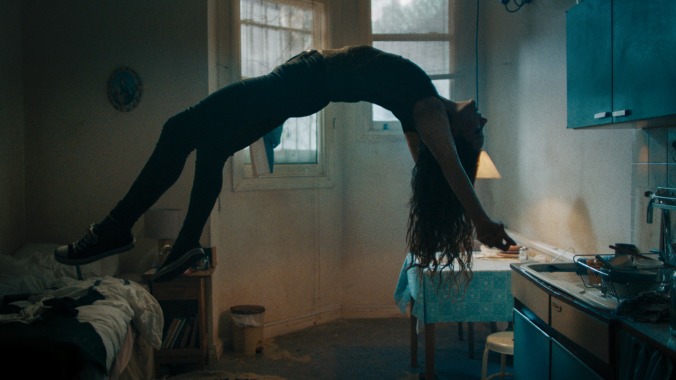The new converts are usually the most intense. Even those raised in an evangelical environment complete with speaking in tongues and creationist puppet shows (à la the subjects of the infamous
) can’t compete with the flinty fervor of an ex-addict who’s found God. Some even replace old vices with religion, in a kind of one-to-one swap of self-destructive obsession. Such is the case with the title character of writer-director Rose Glass’ first feature. Maud (Morfydd Clark), a home nurse with a troubled past, depends on her regular fix of communion with the divine in order to stay on her newfound righteous path. And when she doesn’t get it? Well, you’ll see.
Saint Maud’s combination of talky chamber drama, Paul Schrader-esque character study, and visceral body horror is an ideal fit for A24. In fact, the film contains a scene that’s in direct conversation with an oft-quoted sequence from one of the distributor’s early “elevated” horror triumphs, The Witch. And if there’s no taste of butter for Saint Maud, that’s because her supernatural visitor is the Old Testament type of angel, the kind that inspires both transcendent awe and bone-shaking fear. The religious terror in this film is specifically Catholic in nature, drawing from the church’s traditions of mysticism and self-mortification: Maud walks around with tiny beds of nails in her Converse shoes and experiences transcendent visions that, to cynical secular eyes, look more orgasmic than divine.
That’s how her latest employer, retired dancer Amanda (Jennifer Ehle), sees it. Once the toast of London and New York, Amanda has retreated to a stately mansion in the English seaside town of Scarborough—a location only slightly more appealing than the frigid beaches in Ammonite—to live out her last days. Amanda is dying of cancer, and her fear of what happens next leads Maud to presume that the saving of Amanda’s soul is also imminent. But while her live-in nurse is upstairs in her room kneeling on popcorn kernels and praying for her employer’s soul, Amanda is saying goodbye to life on Earth in her own way—namely, via one last champagne-fueled fling with a local girl, Carol (Lily Frazer). Maud’s binary thinking doesn’t allow her to reconcile her affection for Amanda with her church’s rigid anti-LGBTQ+ doctrine, a disconnect that will drive Maud to shocking acts of what she sees as contrition.
Ultimately, however, the film’s deepest conflict is within its title character. Halfway through, Saint Maud shifts from a love triangle to an unstable loner losing touch with reality, and while Clark was previously playing off of Ehle, now she carries the film alone. She’s mostly up for the task, particularly in terms of physicality—some of her eye-rolling contortions are downright chilling. But there is an emotional disconnect to Maud’s descent that may or may not be part of Glass’ master plan. And Clark’s performance, however vulnerable, lacks the fire in the belly that made Ethan Hawke’s similarly troubled believer so powerful in Schrader’s First Reformed. Rather than steadily escalating its tension, Saint Maud moves—perhaps appropriately, given its preoccupation with sin—more like a serpent, winding from side to side until lunging at the audience in an unnerving surprise attack.
You have to stay engaged with this film until literally its final seconds to feel its full impact. But the journey itself is hardly unpleasant. Glass stages her scenes in striking tableaux, and filters a color palette dominated by rich mahogany, aquatic green, and blushing peach through sickly fluorescents and pale, dusty sunlight. The score from newcomer Adam Bzowski provides all the requisite deep thrums and bows across screeching strings, and while the digital effects don’t always live up to the practical makeup, that’s understandable—this is a relatively low-budget independent film.
Saint Maud is at a disadvantage in terms of timing—and not just because the film’s release was delayed almost a full year by the COVID-19 pandemic. It’s also arriving relatively late in the “elevated horror” cycle spurred by its own distributor. That said, Saint Maud distinguishes itself through an emphasis on character over metaphor, as well as the nightmarish depths of the darkness at its center. We only get to see the true ferocity of Glass’ vision for a few fleeing moments, but have faith: It’s enough to burn into your soul forever.


